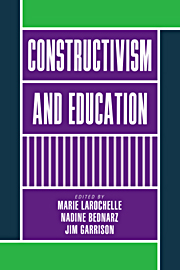Book contents
- Frontmatter
- Contents
- Preface
- List of contributors
- I Introduction
- II From epistemological constructivism to teaching: a variety of views
- III Teaching within the constructivist mode: practices and promises
- IV The mediating role of teachers and teacher education
- 12 Sociocultural perspectives on the teaching and learning of science
- 13 Remarks on the education of elementary teachers
- 14 Constructivism as a referent for reforming science education
- V Conclusion
- Notes
- References
- Index
13 - Remarks on the education of elementary teachers
Published online by Cambridge University Press: 04 August 2010
- Frontmatter
- Contents
- Preface
- List of contributors
- I Introduction
- II From epistemological constructivism to teaching: a variety of views
- III Teaching within the constructivist mode: practices and promises
- IV The mediating role of teachers and teacher education
- 12 Sociocultural perspectives on the teaching and learning of science
- 13 Remarks on the education of elementary teachers
- 14 Constructivism as a referent for reforming science education
- V Conclusion
- Notes
- References
- Index
Summary
The main thesis of this chapter is that the culture of teacher education must share the core characteristics of the desired mathematics classroom culture. In particular, this relationship must hold if teacher education is to exercise a reforming influence on in-service teachers and create a break in the circle of reproduction by which the weaknesses of the existing school system are perpetuated. It follows that more attention should be devoted to the relation between alternative classroom experiences and theoretical instruction, to the fundamental role of everyday language for the understanding of mathematics, the balance of self-directed work and the negotiation of meanings in seminars and tutorials, and to the development of reflection and self-monitoring. Our remarks can be grouped according to five main questions:
What can learning and teaching mean for students and for teachers?
What are the relevant effects of current teacher education?
What does research say about the necessary reforms of teacher education?
How might we promote necessary changes in teachers’ basic orientations and routines?
Given the necessary changes in teacher education, what are the available options?
Clearly, there are no simple, definite answers. Accordingly, the following comments should be viewed more as suggestions or possible options to be worked out at some time in the future. It is my belief that small-scale reform experiments are more effective than largescale, top-down reform efforts.
- Type
- Chapter
- Information
- Constructivism and Education , pp. 213 - 232Publisher: Cambridge University PressPrint publication year: 1998



